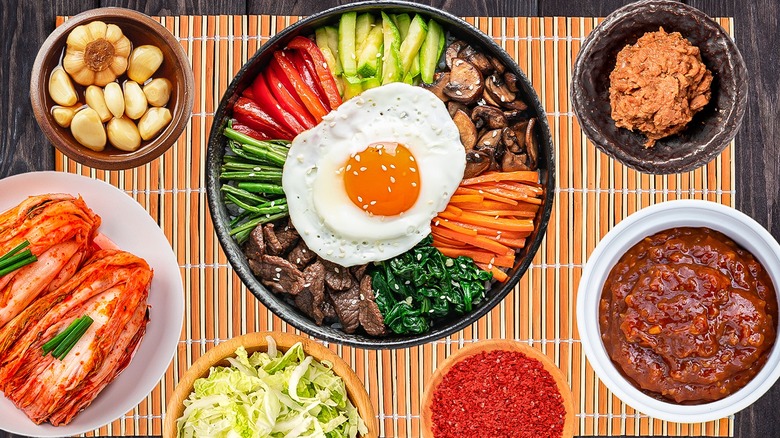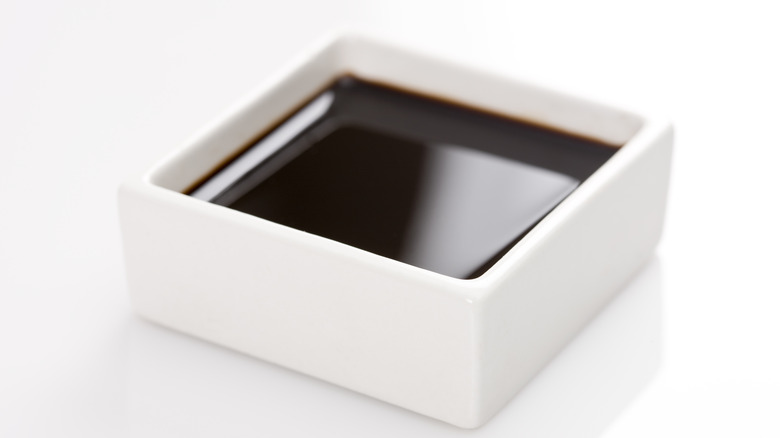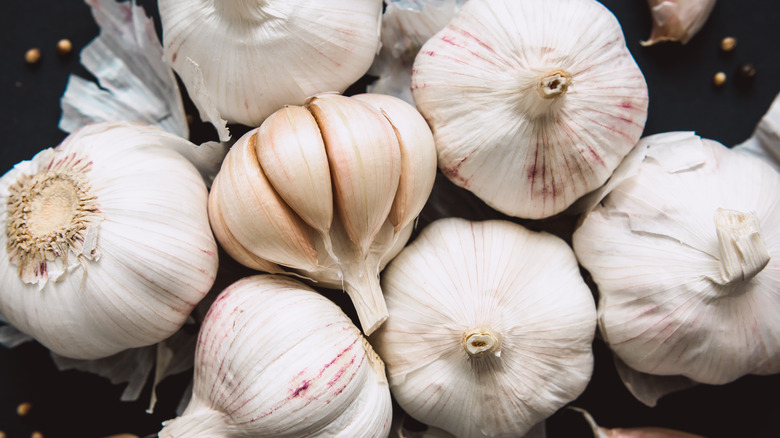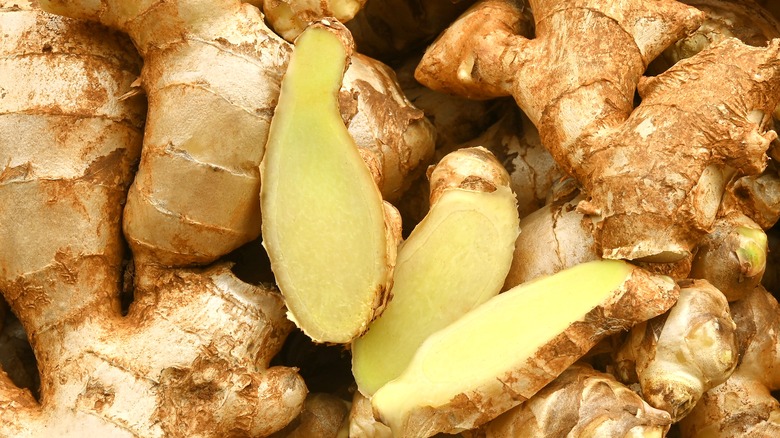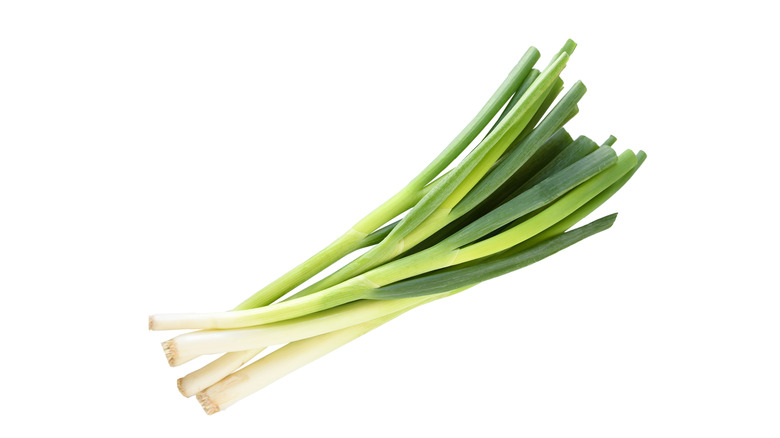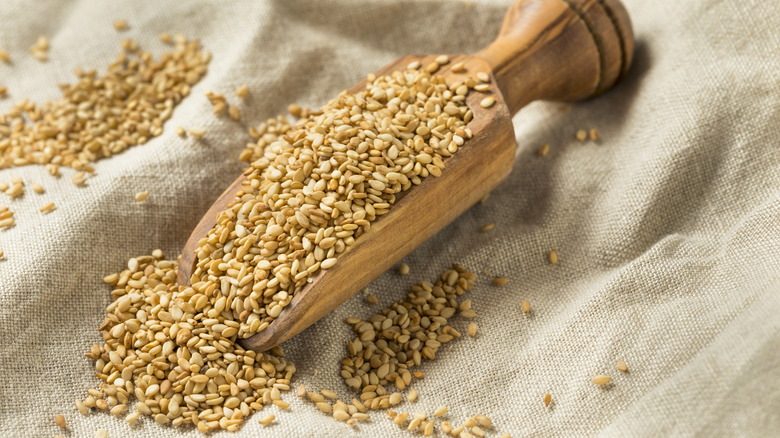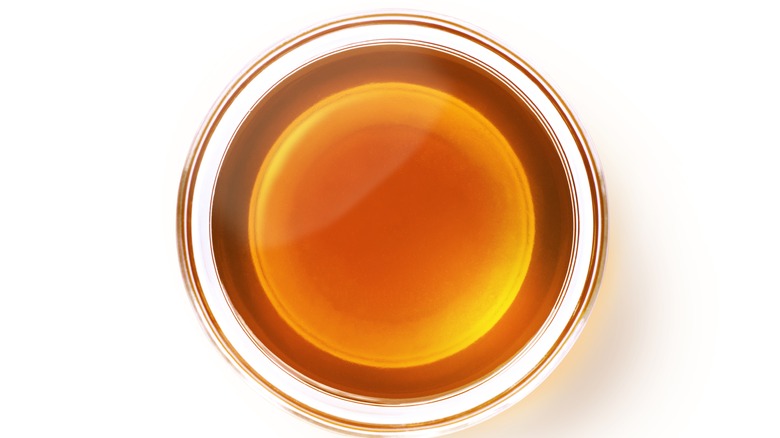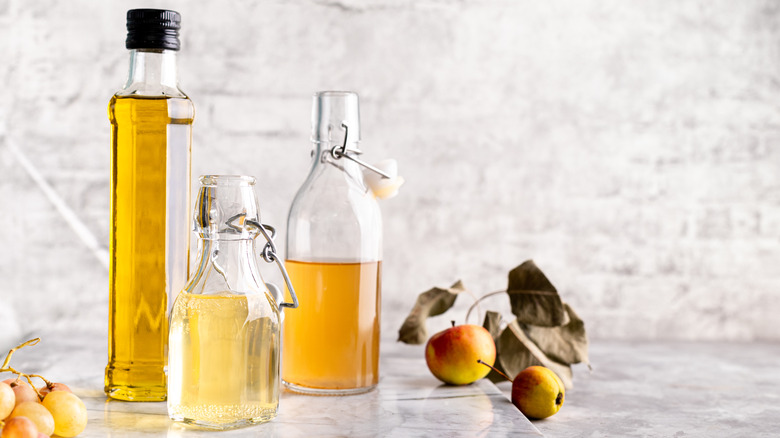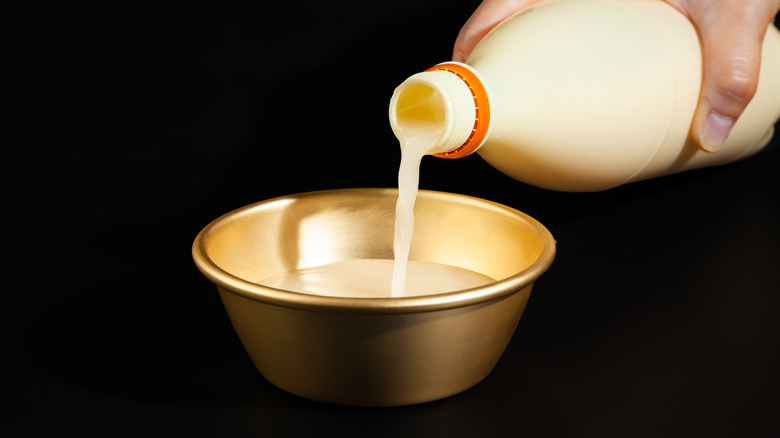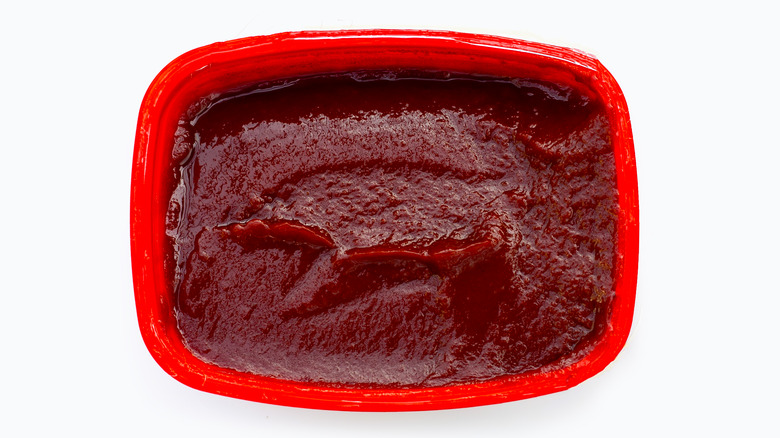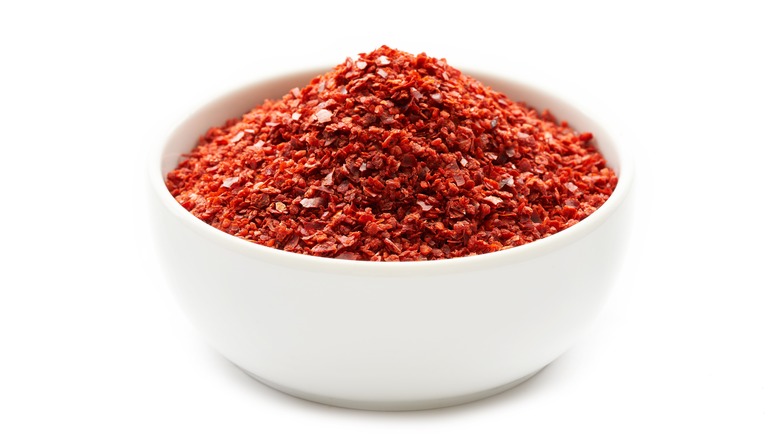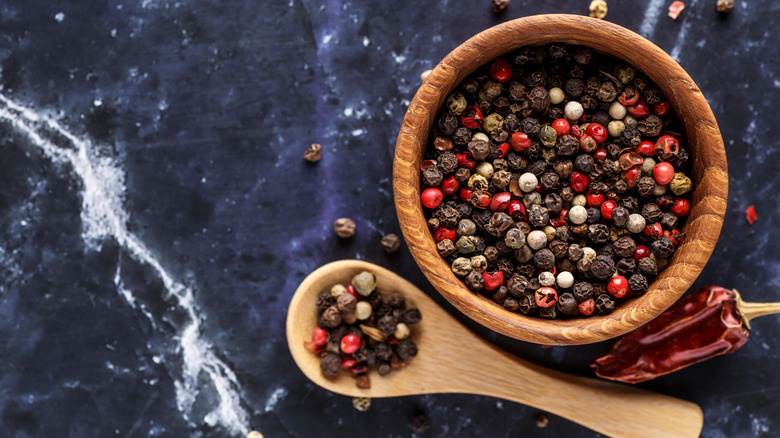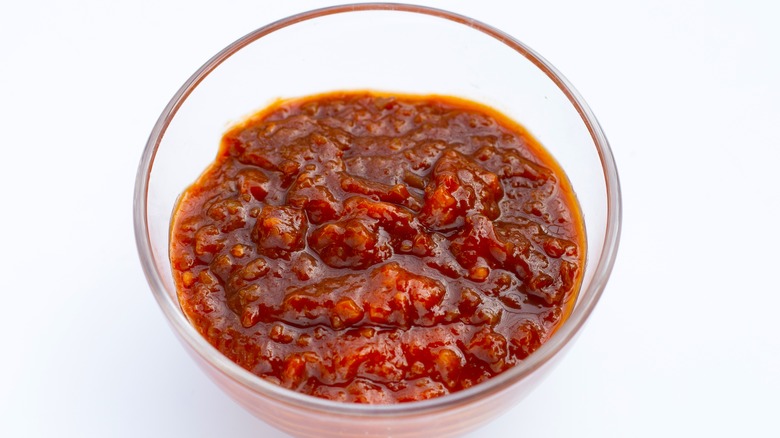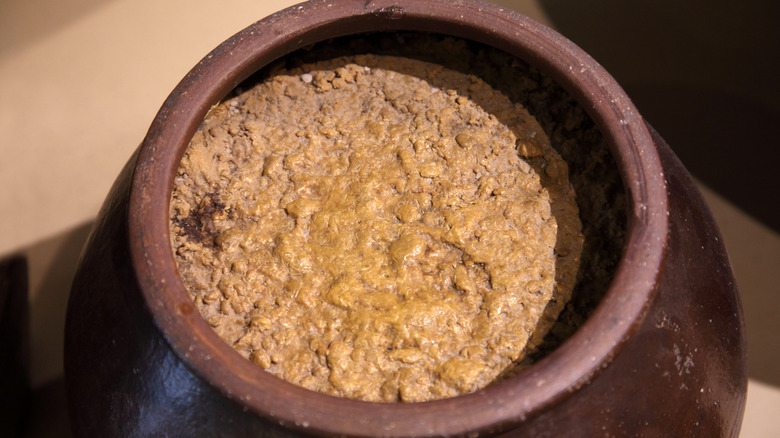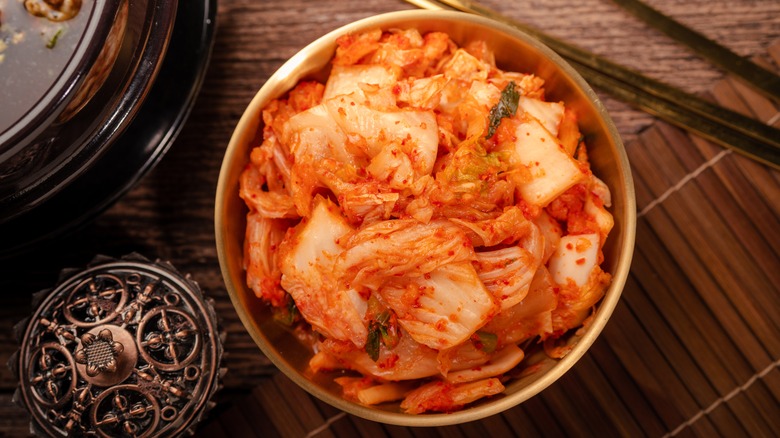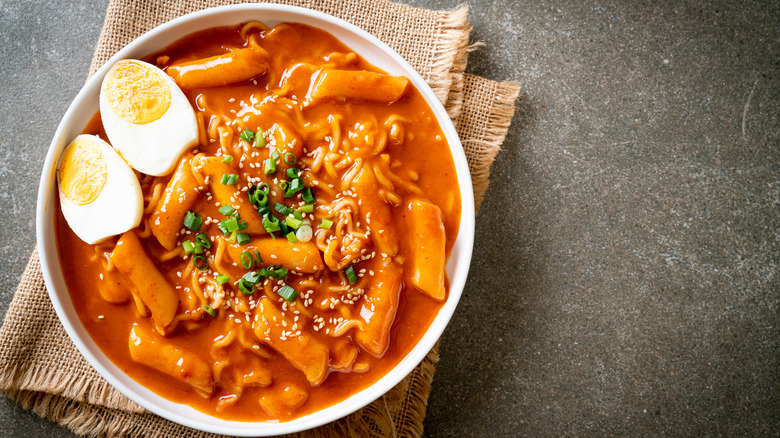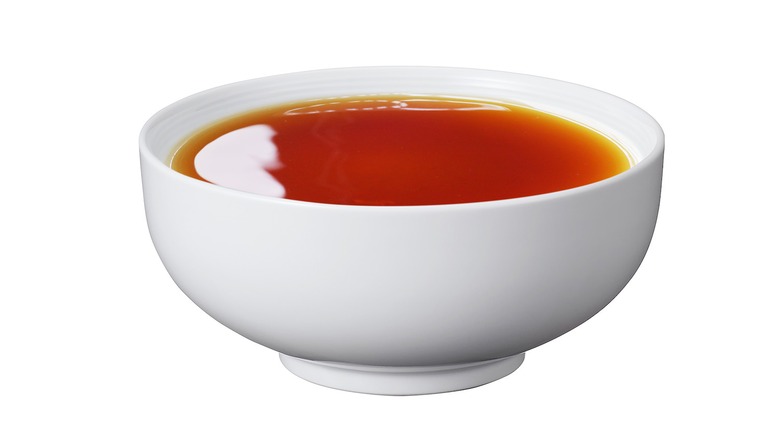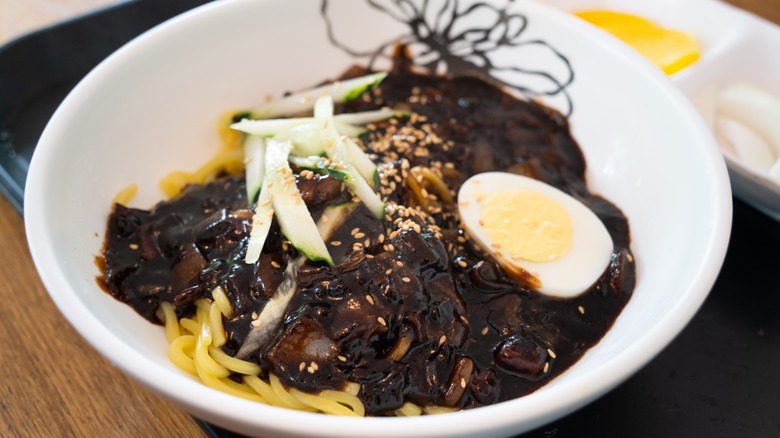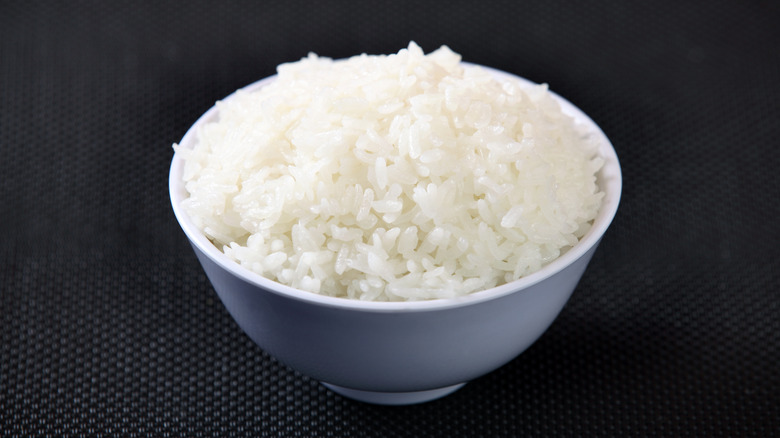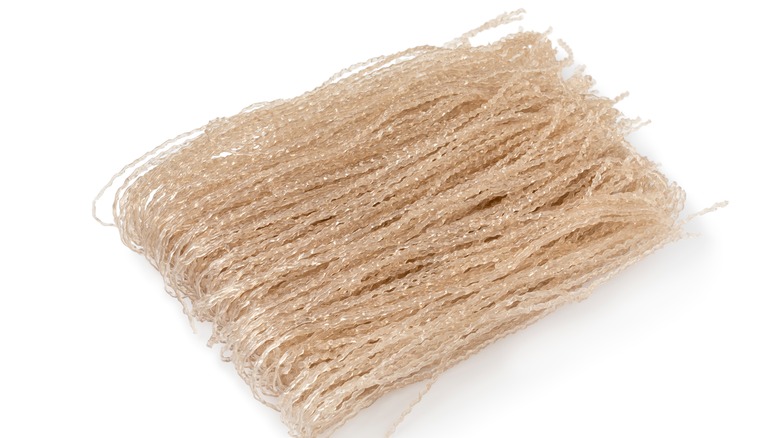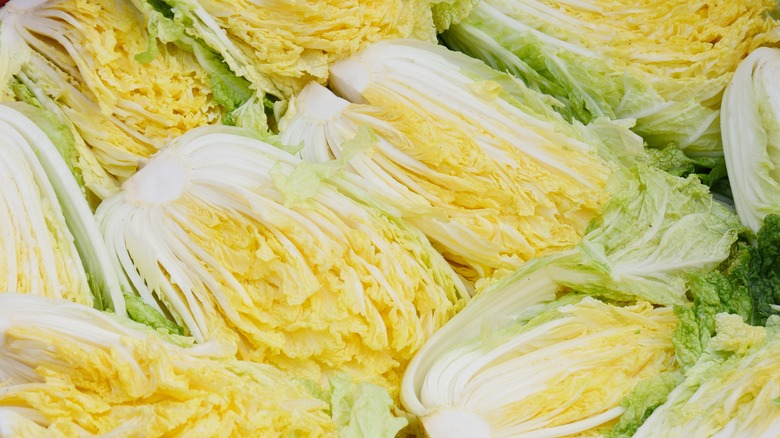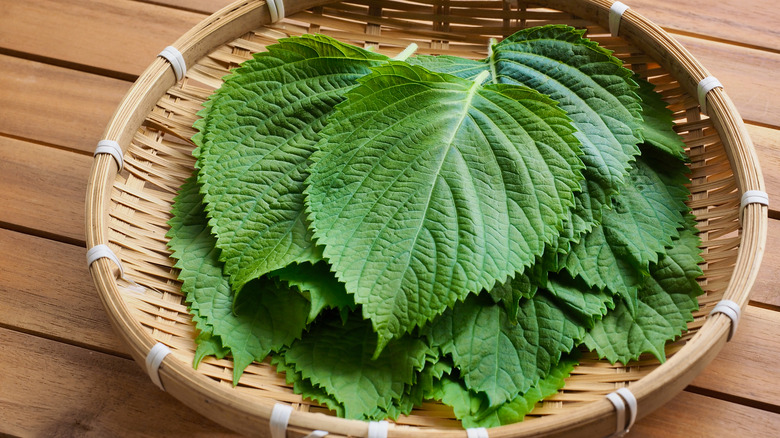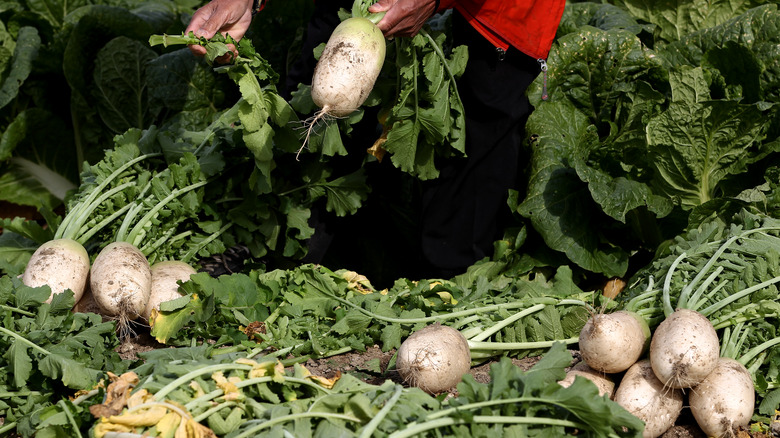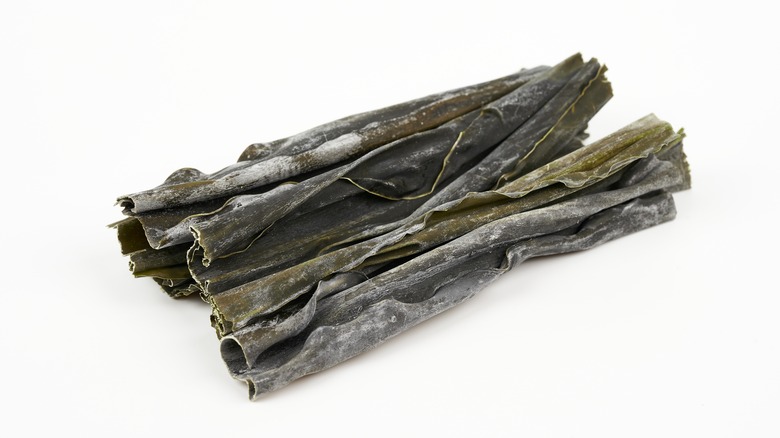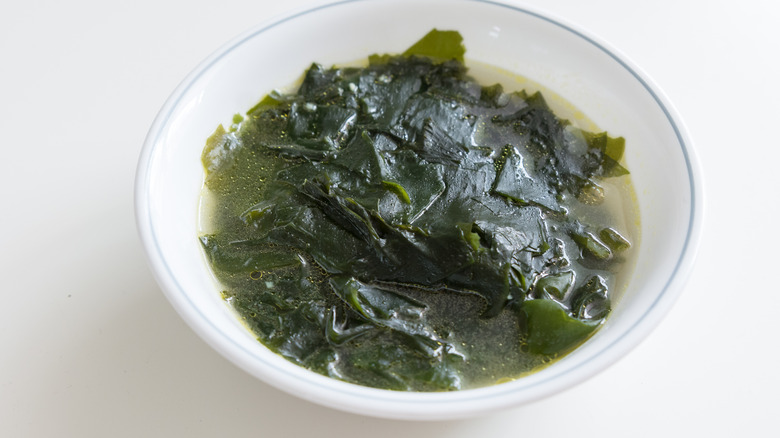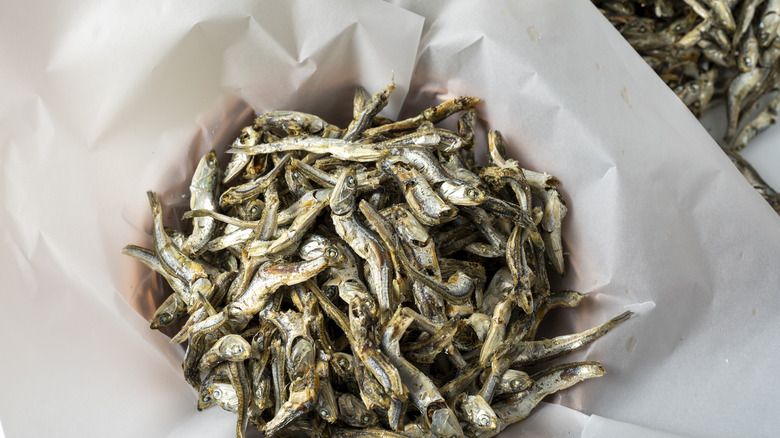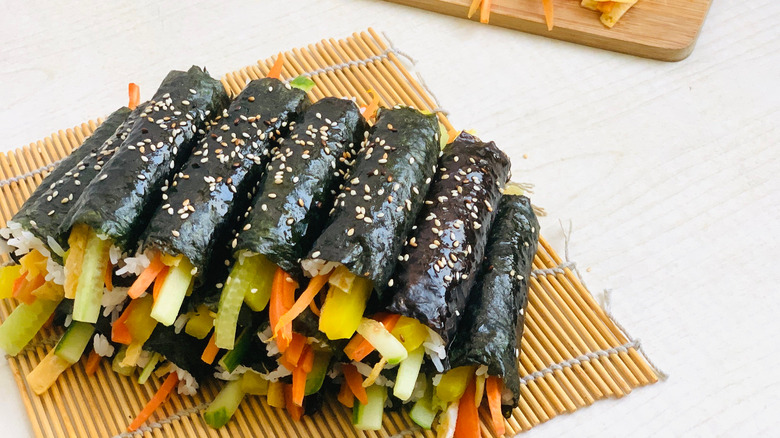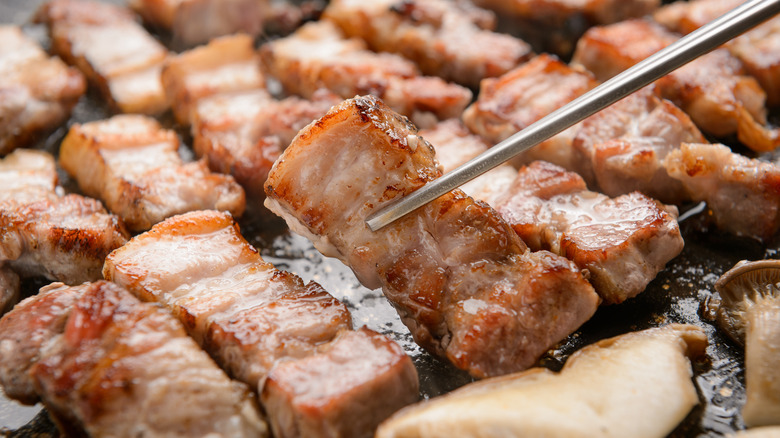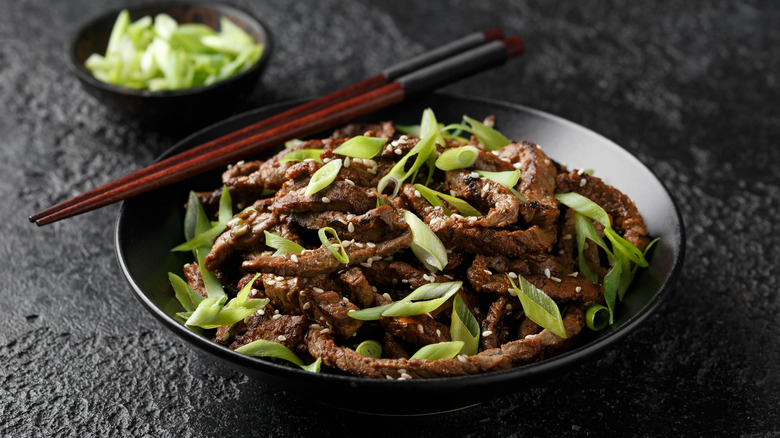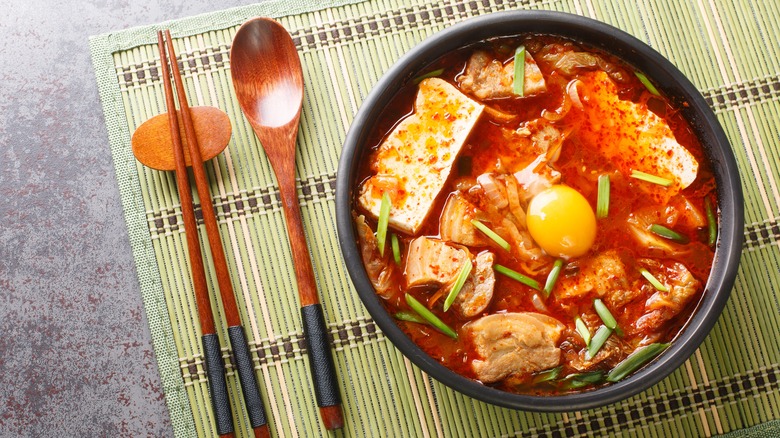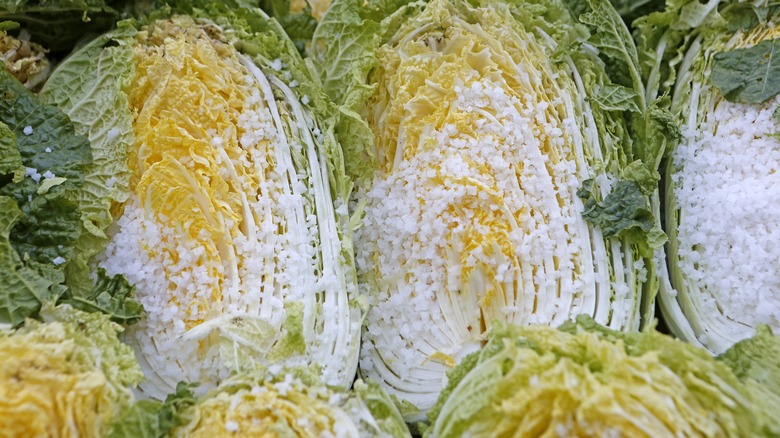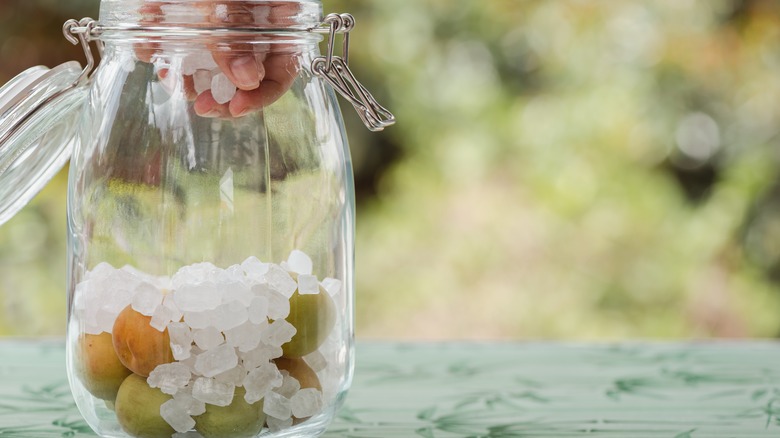32 Essential Ingredients For Korean Cooking
Korean cuisine is known for its celebration of fermented foods, umami-packed seaweeds and dried fish, fragrant broths, and its abundance of vegetables, often served as side dishes or banchan. Some of the country's most popular or well-known dishes have also come out of resourcefulness, like army stew or budae jjigae.
Healthy, flavorful, and with an emphasis on communal dining, learning to make and appreciate Korean cuisine at home can also serve as a delicious insight into reducing waste in the kitchen. Whether ingredients are fermented, used in stews or soups, or dried and used as seasoning, there is a huge emphasis both in the cuisine and culture on extracting the most flavor from every available resource.
Whether you make Korean dishes on a regular basis or are just beginning to dip a toe into the cuisine, a well-stocked pantry with some staple ingredients is a must. Here are x ingredients essential to Korean cuisine to look out for on your next trip to H Mart or your local Asian supermarket.
Ganjang - Korean soy sauce
Though soy sauce is prevalent throughout many Asian cuisines, soy sauce is not a monolith. Soy sauces vary slightly in texture, color, and taste, depending on their country of origin. Korean soy sauce, or ganjang, is a commonly used ingredient and one to keep on hand for Korean home cooking.
Ganjang delivers a slightly different flavor than its Chinese and Japanese counterparts. It is lighter in color and saltier due to its lack of sugar. There are several varieties and uses of Korean soy sauce. Joseon ganjang, the saltiest of the types, is primarily used for soup and banchan, or side dishes. Yangjo ganjang is slightly sweeter for dipping sauces, and jin ganjang combines naturally fermented soy with chemically produced soy for a more cost-effective product used in higher quantities.
Manul - garlic
Garlic is essential in many global cuisines, including Italian, Mexican, Greek, and Korean. Having garlic in the kitchen is as essential as having a passport – it will take you just about anywhere you want to go!
In Korean cuisine, garlic can be minced for flavor to marinate meats or in sauces. Whole garlic cloves are also whole in slower braised foods, home-cooked stews, and soups. Garlic cloves can be pickled as a flavorful banchan or side dish known as manuel jangajji to accompany barbecued meats or balance a meal.
Saenggang - ginger
Like garlic, ginger has been used for food and medicinal purposes across many cultures and communities for thousands of years. In Korean cuisine, ginger is often used with other aromatics as a marinade for meat. It can add complexity to savory sauces or simple syrups for desserts.
Ginger root is also medicinally used as a tea, as it has been known to treat arthritis, support immune health, and warm the body during colder months of the year. Traditional drinks like sujeonggwa, a sweet cinnamon and ginger punch, are often consumed in the wintertime as a sweet finish to a meal with immune-boosting benefits.
Pa - scallions
Pa, or scallions, are the key ingredient in the country's most popular dish, pajeon. 'Pa' – means scallion, and 'jeon' means 'pan-fried.' Recipes for pajeon don't scrimp or waste either, using the entirety of the scallion, celebrating the sweet oniony flavor and toothsome texture.
Scallions are also used in various ways within Korean cuisine, including dishes like pa muchim, a popular banchan. Scallions are thinly sliced into strips and then marinated in a bath of sesame oil (chamgireum), rice vinegar, and Korean chili powder (gochugaru). The result is a brightly flavored sweet-sour-spicy dish, often served alongside barbecued meats or tucked into a lettuce wrap.
Toasted sesame seeds
Not just sesame seeds, but toasted sesame seeds specifically, provide a foundational flavor within Korean cuisine. You can buy the raw sesame seeds yourself and then toast or roast them at home using a dry pan or oven, or you can also buy them pre-toasted in various Asian supermarkets.
Toasting helps release the seeds' oils and enhances their nutty flavors, adding depth of flavor and texture when cooking. Toasted sesame seeds are often used within marinades to finish a dish or garnish a banchan.
Chamgireum - sesame oil
Like toasted sesame seeds, toasted sesame oil is a prevalent ingredient in Korean cuisine, so worth investing in when building a Korean pantry at home. Korean cuisine generally favors toasted sesame oil rather than untoasted, which is made from toasted sesame seeds for a more intensely nutty flavor.
Sesame oil is used as a base for many dishes, in marinades and sauces, and as a flavorful and aromatic finishing oil. From bulgogi to bibimbap, sesame oil is foundational to some of the cuisine's most widely loved and well-known dishes.
Rice wine vinegar
Rice wine vinegar is a well-loved staple across a wide range of Asian cuisines. Rice wine vinegar is often used to add sweet-and-sour flavors quintessential to many regional Asian and Korean dishes. Made from fermented rice, this pantry staple is used in various ways, from pickles to marinades to sauces, and is a must-have for Korean home cooking.
While there are several kinds of rice wine vinegar, brown rice vinegar, made from brown instead of white rice, is used most often in Korean cuisine. Though used similarly, brown rice vinegar provides a slightly different flavor than white rice vinegar, but either would be worth having in the kitchen cupboard.
Rice wine
Rice wine, not to be confused with rice wine vinegar, is a different ingredient altogether. Made from fermented glutinous rice, the sugars in the rice are converted into alcohol, aged, and distilled to increase its sweet taste. When used in cooking, the alcohol is usually burned off. Rice wine can also be enjoyed on its own as a drink.
Mirim is a type of rice wine used in Korean cuisine. It has been compared to other rice wines like sake but is much lower in alcohol. Mirim is generally reserved for cooking, while makgeolli is a fermented rice wine that is often enjoyed as a drink.
Gochujang - Korean chili paste
Made from gochugaru or red chile pepper flakes, glutinous rice, fermented soybeans, and salt, gochujang is a staple Korean ingredient. Gochujang's uniquely sweet, savory, and spicy flavor profile possesses the culinary equivalent of the Midas touch — every dish it is added to turns to gold.
Unlike other hot sauces, gochujang is a concentrated paste. It should be somewhat diluted and added into soups, sauces, and glazes for best flavor and balance rather than heaped onto a finished dish.
Gochugaru - ground dried Korean chiles
Those who love Korean cuisine owe a big thanks to gochugaru. These ground and dried Korean chiles are responsible for a lot of the heavy lifting. Staple dishes and condiments, including kimchi and gochujang, and classic dishes like budae jjigae or army stew all derive much of their flavor from gochugaru.
Gochugaru is known for its complex flavor profile; made from taeyangcho chili peppers, which are then dried and ground into powder or flakes, gochugaru adds a smoky, sweet element alongside a good kick of heat to dishes.
Huchu - ground black pepper
Korean ground black pepper is uniquely aromatic and a staple marinade seasoning in Korean barbecued meats and other dishes. Grown in the southwest of South Korea, Korean black pepper is often farmed using traditional methods before the ripe berries are harvested by hand before they are fully mature and then dried.
Korean black pepper or huchu is a type of black pepper known for its citrus and floral aromatic flavor and lends itself to both sweet and savory dishes across the cuisine. It can also be found in dishes like tteokguk or rice cake soup, traditionally eaten to celebrate Korean New Year.
Ssamjang - dipping sauce and marinade
Condiments and sauces are an essential part of Korean cuisine, which is why a Korean pantry should include ssamjang, a marinade, dipping, or "wrapping" sauce (ssam means "wrap") used frequently throughout the cuisine.
Made from an umami-bursting combination of red miso, gochujang or chile paste, scallions, garlic, sugar, and sesame oil, it's no wonder this paste is so beloved. Ssamjang can be used as a dip for Korean lettuce wraps or ssambap, as a marinade or finishing glaze for barbecued meats, or incorporated into a sauce for an extra umami oomph.
Doenjang - fermented soybean paste
Korean staple doenjang should be your first port of call for anyone looking to add a burst of umami to their dishes. Not to be confused with its spicier counterpart, gochujang, doenjang is made from fermented soybeans rather than chiles. Doenjang is essential to cooking flavorful Korean dishes at home.
Doenjang's history in Korean cuisine dates back to the 3rd century when soybeans were fermented using earthenware pots. Now, we can simply pick up a container of the fermented paste at any Asian or Korean grocery store. Doenjang is used in various dishes, from ssamjang (a dipping sauce for Korean lettuce wraps) to doenjang jjigae (soybean paste stew), so it is well worth the investment.
Kimchi - fermented baechu (napa cabbage)
Considered to be both a dish and an ingredient, kimchi is eaten so regularly that we'd be remiss not to include it on this list. Comprised of several other essential ingredients, including gochugaru or Korean chile pepper, Napa cabbage (baechu), fish sauce (aekjeot), and salt, kimchi is one of an array of banchan, served with most meals. Though traditionally made from baechu or napa cabbage, many other types of kimchi are also available, from radish to cucumber to scallions (pa).
Tteok - Korean rice cakes
Tteok is a delightfully chewy, stubby, cylindrical rice cake prevalent in dishes like spicy tteokbokki, a stir-fried dish made with rice cakes, gochugan, gochugaru, and soy sauce. They are also a handy ingredient to pick up at your local Korean or Asian supermarket and tuck into your freezer.
Perfect for serving on their own, tteok can also be added to soups and stews, much like dumplings or even stir-fries. They're fantastic at absorbing sauces and creating textural variety and hearty enough to stretch any dish just a little bit further. Tteok can also be used in desserts such as sirutteok, made with red beans and served at milestone events such as birthdays and weddings.
Jeot or Aekjeot - Korean fish sauce
So essential is fish sauce within Korean cuisine that there are many types of fish sauce (aekjeot) to choose from. Depending on what specific flavors you're after, varieties of fish sauces include anchovy, sand lance, and shrimp.
No matter which type of fish sauce you choose, fish sauce is a staple of Korean cuisine, used in everything, including kimchi. It's a fantastic way to build umami flavors that Korean cuisine is known for and worth stocking at home.
Chunjang - Korean soybean paste
This inky, thick condiment bursts with rich, caramelized umami flavors. Chunjang, also known as jjajang, is surprisingly bitter when eaten on its own; the key to removing its bitterness is to sauté it with oil before using.
Made from fermented soybeans and wheat flour, it is an essential ingredient in making jjajangmyeon. This Korean-Chinese dish punctuates chewy, satisfying noodles by coating them in a rich, velvety, almost gravy-like sauce.
Though chunjang could be likened to Chinese fermented black bean paste, its flavor varies slightly to accommodate Korean palates. While it can be found in the condiment section, once opened, chunjang must be stored in the fridge and can last for several months.
Bap - short grain white rice
Cooked rice or bap plays an enormous role in Korean cuisine. Present at most meals, rice is a great way to soak up sauces and provides a filling, delicious balance to a flavorful meal.
While several kinds of rice are eaten throughout Korea, including glutinous and black rice, Korean white rice is one of the most popular. Korean white rice is one of the shorter grains and has a stickier texture compared to other varieties from around Southeast Asia. Its soft texture and gentle flavor make it easy to digest, making it a popular choice for everyone from the very young to the very old.
Dangmyeon - sweet potato noodles
Dangmyeon or sweet potato noodles are made from sweet potato starch and are a staple in Korean dishes like japchae, a deliciously savory, toothsome stir fry, often made as a celebratory dish, that's been around since the 17th century.
Dangmyeon are unique in their appearance and their texture. Clear in appearance, they are often called glass noodles or cellophane noodles. The noodles have a wonderfully satisfying bite, making them a well-appreciated ingredient when adding textural variety. They're also easy to cook; they need only a few minutes in hot water or stock to transform from straw-like to palate-pleasing.
Baechu - napa cabbage
Napa cabbage is a highly adaptable, hearty-yet-tender vegetable. Unlike rounder cabbages, napa cabbage or baechu is known for its elongated shape, light green color, and hearty stalks. It is the main ingredient to create kimchi, a spicy, fermented banchan served as a side dish at most meals. Kimchi is also known as South Korea's national dish.
Napa cabbage thrives in cooler conditions and is often planted in the summer and harvested in the autumn. However, the climate crisis is providing enormous challenges. In 2022, the price of baechu skyrocketed due to its shortage due to the sweltering and wet summer, worrying for a nation that uses baechu as one of its staple dishes.
Gganip - perilla leaves
Perilla leaves, or ggaenip, are aromatic green plants that can be treated like a herb, lettuce, or vegetable, depending on the dish. Gganip are part of the mint family and are used in various ways and dishes throughout Korean cuisine. They can also be easily grown at home in full to partial sun on a window sill or garden. Similar to shiso leaves used in Japanese cuisine, leaves can be pickled and served as a banchan, tucked into ssam or wraps, or as part of a stir fry.
Korean radish or daikon
Radishes provide a crisp, clean, if not slightly spicy, flavor, adding texture and balance to any meal. Korean radishes, often somewhat sweeter than other varieties, can be used in various ways. They are usually braised in soups or stews and served alongside heavier dishes like barbecued or roasted meats as a quick pickled banchan. Korean radishes are known for their crisp texture, peppery flavor when raw, and their ability to become sweeter with a soft, velvety texture when cooked.
Dasima - dried kelp
Dasima or dried kelp is often used as a base ingredient in broths to enhance satisfying umami flavors and provide nutrition. Most commonly dried out and sold in sheets, it is a wonderful shelf-stable ingredient that can last for months as long as it's stored in an air-tight container away from moisture.
To use, simply add stock to rehydrate. Once the broth has been gently flavored, you can remove the dasima to be sliced and eaten on the side. Dasima is also a rich natural source of iodine, packed with vitamins and minerals.
Miyeok - dried seaweed
While dasima or dried kelp refers to a specific kind of seaweed, miyeok is the more general term for the underwater-based plant. Seaweeds of various sorts are a mainstay in many Asian cuisines, known for their texture, umami-packed flavor, and as a rich source of minerals.
Miyeok is the main ingredient in Korean seaweed soup or miyeok guk, a light and flavorful soup customarily served as part of a birthday celebration and to new mothers to aid with lactation and recovery.
Marun myeolchi - dried anchovies
Small, pungent dried fish like scallops, shrimp, and anchovies are known for delivering a punch of flavor in small, concentrated amounts. Widely used across many Asian cultures, Korean cuisine is no different, with marun myeolchi serving as a staple ingredient behind many of the region's most flavorful dishes.
Dried anchovies are key in creating the satisfying and popular lunch box item, myeolchi-ttangkong-bokkeum, made from crunchy peanuts and a savory sauce. Marun myeolchi is also crucial when making sundubu jjigae, a flavorful, spicy tofu stew.
Gim - dried Seaweed
So essential is seaweed to Korean cuisine that there are multiple kinds worth mentioning. Each is valued and used slightly differently. Gim, from the red algae family, is the specific type of seaweed used to create gimbap — its name is a product of gim, meaning dried seaweed, and bap, meaning cooked rice. Packed with rice and peppered with cooked vegetables, proteins, and pickles, gimbap is a popular and healthy dish for eating on the go, from school lunches to picnics.
Samgyupsal-gui - pork belly
Tender, luxurious pork belly makes for a versatile mainstay, used in various ways and dishes in Korean cuisine. Because of its high-fat content, pork belly or samgyupsal-gui adapts well to slow cooking in stews and braises and equally works well when used in hot-and-fast- techniques, like Korean barbecue. Braised pork belly makes a wonderful addition to bibimbap or tucked into a ssam or lettuce wrap, balanced with kimchi and other banchan.
Beef
Beef is a preferred protein choice of many within Korean cuisine, though meat is still eaten in relatively low quantities compared to American standards. Many of the cuisine's staple meat dishes feature a variety of beef cuts, from bulgogi, which uses sirloin, to galbi jjim or braised short ribs.
Communal eating and sharing is a large part of Korean culture and cuisine. Not only are experiences like barbecue delicious, but they evoke feelings of closeness and require interaction between diners. Various cuts of beef are often present during a typical Korean barbecue alongside plenty of vegetables and banchan to balance out the meal.
Tofu
Originating in China, tofu has been a staple part of cuisines across the continent of Asia for thousands of years. Made by curdling soy and also known as bean curd, tofu ranges in a variety of textures and flavors depending on how it is processed.
Tofu is used in a variety of Korean dishes, including braised tofu or dubu jorim and sundubu jjigae, a spicy stew made with tofu, and a potent broth containing kimchi, gochujang, dasima, marun myeolchi, and other umami-boosting ingredients. Packed full of flavor, this nourishing stew will warm and invigorate you from head to toe.
Wang sogeum - salt
While it may seem like a no-brainer, wang sogeum or salt is a key that unlocks the fermentation process, playing a significant role in Korean cuisine, and used with gochugaru to make kimchi and gochujang.
Korean salt generally consists of large grains, comparable in size to kosher salt, sometimes even larger. There are a vast number of salts used throughout Korea. Most are minimally processed, each with a different size, flavor, and purpose.
Mul-yeot - corn syrup
Mul-yeot, or corn syrup, means "sweet liquid candy." There are two types of mul-yeot, either clear and slightly thinner, made from corn, and brown, which uses rice. Either can be used to sweeten both savory and sweet dishes. It is also used to give food a gloss or shine.
Mul-yeot is often used when making a quick stir fry, adding a glossy texture to the finish while helping to soften meat. Given its ability to tenderize and velvet, mul-yeot can also be used in marinades for meat.
Maesil cheong - plum syrup
Maesil cheong is made from sour, green plums and sugar. It is a ubiquitous plum syrup, used widely across Korean cuisine as a flavorful substitute for sugar. The plums, known for their health properties, are fermented in sugar for around one hundred days, extracting a unique depth of flavor due to the fermentation process.
After fermentation, you'll have a thick, sweet, and sour amber-colored syrup. The syrup can be strained and stored, added to a cold drink or tea, or used to sweeten dishes instead of sugar.
